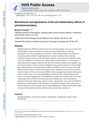Transcranial Photobiomodulation for Brain Diseases: Review of Animal and Human Studies Including Mechanisms and Emerging Trends
February 2024
in “
Neurophotonics
”
TLDR Light therapy on the brain shows promise for treating brain diseases and improving brain function.
Transcranial photobiomodulation (tPBM), a non-invasive brain stimulation therapy using low irradiance red to near-infrared light, has shown potential in treating various brain diseases such as Alzheimer’s disease, Parkinson’s disease, traumatic brain injury, depression, and aging. The therapy enhances mitochondrial activity and ATP biosynthesis, increases cell respiration, brain energy metabolic capacity, brain electrophysiological oscillation strength, and improves cerebral oxygenation. It also reduces inflammation and improves lymph flow. In Alzheimer's Disease, tPBM improved cognitive and memory ability, and in Parkinson's Disease, it showed potential in slowing disease progression. It also improved motor performance in Multiple Sclerosis, mitigated neuron death in Traumatic Brain Injury, and improved cognition and mood in Chronic Traumatic Encephalopathy. For depression, tPBM improved depressive symptoms. Despite these promising results, the mechanisms underlying the therapeutic effects of tPBM are not yet fully understood and require further study.

